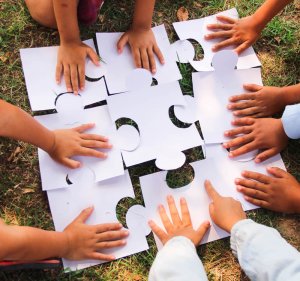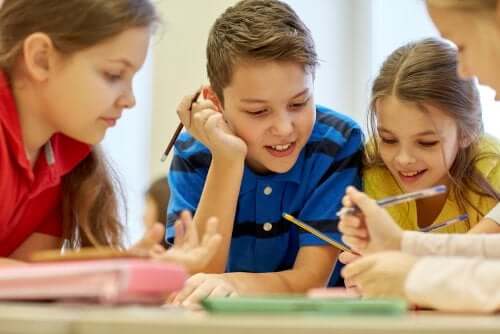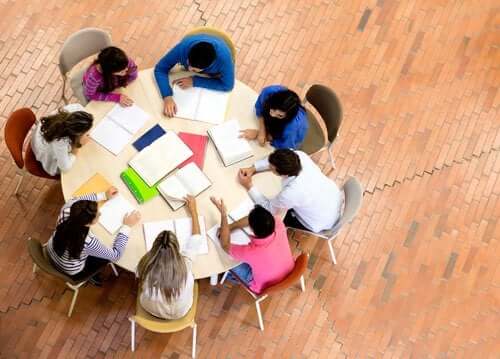How to Encourage Cooperative Learning in Children


Written and verified by the psychologist Ana Couñago
It’s crucial to encourage cooperative learning in children so that they learn to work in teams from a young age. Certain collaboration strategies are helpful in teaching them this important life skill, and you can put them into practice at school.
In fact, school is the best setting for teaching children about cooperation. It’s the place where kids spend a large part of their day and where they’re in constant contact with other classmates.
What is cooperative learning?
Cooperative learning is an education focus that consists of forming groups of students to work together to carry out academic activities in a coordinated fashion. These groups should be:
- Small.
- Mixed.
- Heterogenous.
Cooperative learning turns children into the protagonists of their own learning. Given that they take in new knowledge in an active and autonomous way under the guidance and supervision of their teachers. Therefore, we can say that the objectives of cooperative learning are as follows:
- Encouraging positive social relationships among students.
- Maximizing respect for and acceptance of diversity.
- Helping students to become autonomous and independent in the construction of their own learning.

- Improving group cohesion.
- Forming a climate of positive coexistence.
- Tending to the educational needs of all students.
- Reducing academic failure.
How to encourage cooperative learning in children?
To encourage cooperative learning in children and maximize collaboration among students, you need to know how to put a variety of educational strategies into practice, such as peer tutoring or interactive groups. Below, we’ll explain what each of these techniques involves.
Peer tutoring
Peer tutoring is a collaborative strategy that consists of forming pairs among students. Each of the partners will assume one of the following roles:
- Tutor. The partner that’s responsible for teaching.
- Learner. The apprentice.
Partners should work together towards a common objective, which they both share and know. They achieve this objective within a framework of interaction planned by the professor.
With this learning technique, peer tutors learn to offer pedagogical assistance to their partners. This involves preparing content in a reflexive manner in order to be able to explain it to their partners. What’s more, they need to be able to formulate questions about knowledge, ideas, relations, and principles.
At the same time, apprentices learn thanks to the personalized and permanent assistance that they receive from their partners. But, to carry this out correctly, the educator needs to:
- Offer feedback to peer tutors regarding their performance and any possible weaknesses.
- Carefully plan the learning process.
- Prepare the right materials.
- Form students in their respective roles.
- Structure the relationship between partners, giving them time to learn how to function.
- Propose tasks that are significant and vital for the students.
What’s more, peer tutors should also evaluate their apprentices, pointing out their advances and progress.

Interactive groups
Another didactic strategy that encourages cooperative learning in children is utilizing interactive groups. This involves forming small heterogeneous groups of between 3 and 6 members. All of the members of a group fulfill an independent role in the task, but with a shared objective.
An adult (teacher, family member, counselor) guides each group and has the task of streamlining the activities and mediating between the learners. At the same time, the teacher in charge of the classroom has the following responsibilities:
- Coordinating tasks.
- Organizing the responsibilities of each member involved.
- Forming the groups.
- Tending to and supporting the needs that arise over the course of the activity.
- Explaining the learning activities.
- Supervising the process and evaluating the students’ achievements.
What’s more, dialogue between children is fundamental for the proper functioning of interactive groups. This dialogue helps children to feel useful and listened to, have a higher self-concept, and improved social skills.
Finally, at the end of each session, groups talk about the work they carried out in order to reflect on the class and reinforce learning.
It’s crucial to encourage cooperative learning in children so that they learn to work in teams from a young age. Certain collaboration strategies are helpful in teaching them this important life skill, and you can put them into practice at school.
In fact, school is the best setting for teaching children about cooperation. It’s the place where kids spend a large part of their day and where they’re in constant contact with other classmates.
What is cooperative learning?
Cooperative learning is an education focus that consists of forming groups of students to work together to carry out academic activities in a coordinated fashion. These groups should be:
- Small.
- Mixed.
- Heterogenous.
Cooperative learning turns children into the protagonists of their own learning. Given that they take in new knowledge in an active and autonomous way under the guidance and supervision of their teachers. Therefore, we can say that the objectives of cooperative learning are as follows:
- Encouraging positive social relationships among students.
- Maximizing respect for and acceptance of diversity.
- Helping students to become autonomous and independent in the construction of their own learning.

- Improving group cohesion.
- Forming a climate of positive coexistence.
- Tending to the educational needs of all students.
- Reducing academic failure.
How to encourage cooperative learning in children?
To encourage cooperative learning in children and maximize collaboration among students, you need to know how to put a variety of educational strategies into practice, such as peer tutoring or interactive groups. Below, we’ll explain what each of these techniques involves.
Peer tutoring
Peer tutoring is a collaborative strategy that consists of forming pairs among students. Each of the partners will assume one of the following roles:
- Tutor. The partner that’s responsible for teaching.
- Learner. The apprentice.
Partners should work together towards a common objective, which they both share and know. They achieve this objective within a framework of interaction planned by the professor.
With this learning technique, peer tutors learn to offer pedagogical assistance to their partners. This involves preparing content in a reflexive manner in order to be able to explain it to their partners. What’s more, they need to be able to formulate questions about knowledge, ideas, relations, and principles.
At the same time, apprentices learn thanks to the personalized and permanent assistance that they receive from their partners. But, to carry this out correctly, the educator needs to:
- Offer feedback to peer tutors regarding their performance and any possible weaknesses.
- Carefully plan the learning process.
- Prepare the right materials.
- Form students in their respective roles.
- Structure the relationship between partners, giving them time to learn how to function.
- Propose tasks that are significant and vital for the students.
What’s more, peer tutors should also evaluate their apprentices, pointing out their advances and progress.

Interactive groups
Another didactic strategy that encourages cooperative learning in children is utilizing interactive groups. This involves forming small heterogeneous groups of between 3 and 6 members. All of the members of a group fulfill an independent role in the task, but with a shared objective.
An adult (teacher, family member, counselor) guides each group and has the task of streamlining the activities and mediating between the learners. At the same time, the teacher in charge of the classroom has the following responsibilities:
- Coordinating tasks.
- Organizing the responsibilities of each member involved.
- Forming the groups.
- Tending to and supporting the needs that arise over the course of the activity.
- Explaining the learning activities.
- Supervising the process and evaluating the students’ achievements.
What’s more, dialogue between children is fundamental for the proper functioning of interactive groups. This dialogue helps children to feel useful and listened to, have a higher self-concept, and improved social skills.
Finally, at the end of each session, groups talk about the work they carried out in order to reflect on the class and reinforce learning.
All cited sources were thoroughly reviewed by our team to ensure their quality, reliability, currency, and validity. The bibliography of this article was considered reliable and of academic or scientific accuracy.
- Chacón, J. P. y Marí, M. L. (2013). Los grupos interactivos como estrategia didáctica en la atención a la diversidad. Ensayos: Revista de la Facultad de Educación de Albacete, (28), 197-211.
- Durand, D., Flores, M., Mosca, A. y Santiviago, C. (2014). Tutorías entre iguales, del concepto a la práctica en las diferentes etapas educativas. InterCambios. Dilemas y transiciones de la Educación Superior, 2(1), 31-39.
- Méndez-Mendoza, R. (2010). Aprendizaje cooperativo. Revista digital para profesionales de la enseñanza, 8.
- Sandoval, M. (2008). La colaboración y la formación del profesorado como factores fundamentales para promover una educación sin exclusiones. Contextos educativos: Revista de educación, (11), 149-160.
This text is provided for informational purposes only and does not replace consultation with a professional. If in doubt, consult your specialist.








